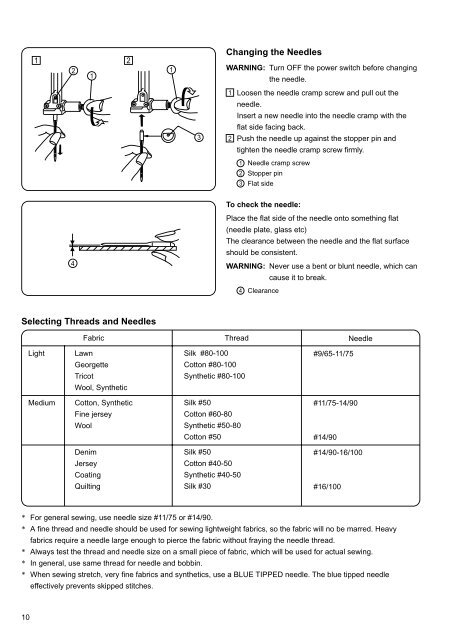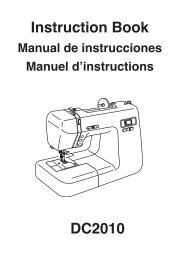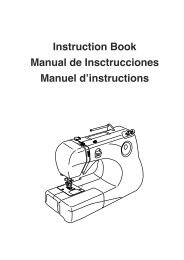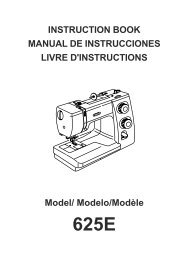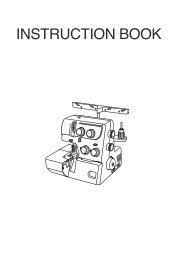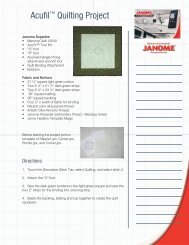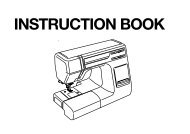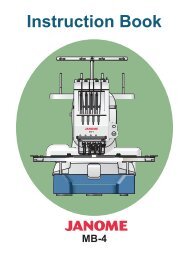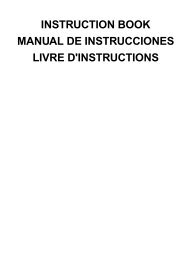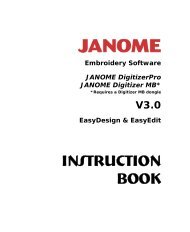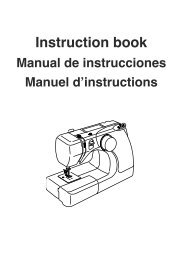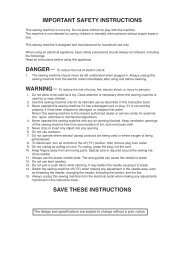instruction book - Janome
instruction book - Janome
instruction book - Janome
You also want an ePaper? Increase the reach of your titles
YUMPU automatically turns print PDFs into web optimized ePapers that Google loves.
1 2<br />
2<br />
1<br />
1<br />
Changing the Needles<br />
WARNING: Turn OFF the power switch before changing<br />
the needle.<br />
3<br />
1<br />
2<br />
Loosen the needle cramp screw and pull out the<br />
needle.<br />
Insert a new needle into the needle cramp with the<br />
flat side facing back.<br />
Push the needle up against the stopper pin and<br />
tighten the needle cramp screw firmly.<br />
1<br />
2<br />
3<br />
Needle cramp screw<br />
Stopper pin<br />
Flat side<br />
To check the needle:<br />
4<br />
Place the flat side of the needle onto something flat<br />
(needle plate, glass etc)<br />
The clearance between the needle and the flat surface<br />
should be consistent.<br />
WARNING: Never use a bent or blunt needle, which can<br />
cause it to break.<br />
4<br />
Clearance<br />
Selecting Threads and Needles<br />
Fabric<br />
Thread<br />
Needle<br />
Light<br />
Lawn<br />
Silk #80-100<br />
#9/65-11/75<br />
Georgette<br />
Cotton #80-100<br />
Tricot<br />
Synthetic #80-100<br />
Wool, Synthetic<br />
Medium<br />
Cotton, Synthetic<br />
Silk #50<br />
#11/75-14/90<br />
Fine jersey<br />
Cotton #60-80<br />
Wool<br />
Synthetic #50-80<br />
Cotton #50<br />
#14/90<br />
Denim<br />
Silk #50<br />
#14/90-16/100<br />
Jersey<br />
Cotton #40-50<br />
Coating<br />
Synthetic #40-50<br />
Quilting<br />
Silk #30<br />
#16/100<br />
* For general sewing, use needle size #11/75 or #14/90.<br />
* A fine thread and needle should be used for sewing lightweight fabrics, so the fabric will no be marred. Heavy<br />
fabrics require a needle large enough to pierce the fabric without fraying the needle thread.<br />
* Always test the thread and needle size on a small piece of fabric, which will be used for actual sewing.<br />
* In general, use same thread for needle and bobbin.<br />
* When sewing stretch, very fine fabrics and synthetics, use a BLUE TIPPED needle. The blue tipped needle<br />
effectively prevents skipped stitches.<br />
10


